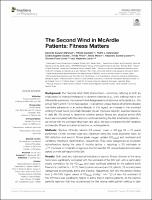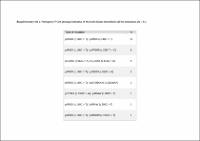| dc.contributor | Vall d'Hebron Barcelona Hospital Campus |
| dc.contributor.author | Salazar-Martínez, Eduardo |
| dc.contributor.author | Santalla Hernández, Alfredo |
| dc.contributor.author | Valenzuela, Pedro L. |
| dc.contributor.author | Nogales-Gadea, Gisela |
| dc.contributor.author | Pinós Figueras, Tomàs |
| dc.contributor.author | Morán, María |
| dc.date.accessioned | 2022-05-30T13:13:41Z |
| dc.date.available | 2022-05-30T13:13:41Z |
| dc.date.issued | 2021-10 |
| dc.identifier.citation | Salazar-Martínez E, Santalla A, Valenzuela PL, Nogales-Gadea G, Pinós T, Morán M, et al. The Second Wind in McArdle Patients: Fitness Matters. Front Physiol. 2021 Oct;12:744632. |
| dc.identifier.issn | 1664-042X |
| dc.identifier.uri | https://hdl.handle.net/11351/7581 |
| dc.description | Glycogenosis type 5; Myophosphorylase deficiency; Ventilatory threshold |
| dc.description.abstract | Background: The “second wind” (SW) phenomenon—commonly referring to both an initial period of marked intolerance to dynamic exercise (e.g., brisk walking) that is not followed by perceived improvement and disappearance of previous tachycardia (i.e., the actual “SW”) until 6–10 min has elapsed—is an almost unique feature of McArdle disease that limits adherence to an active lifestyle. In this regard, an increase in the workload eliciting the SW could potentially translate into an improved patients’ exercise tolerance in daily life. We aimed to determine whether aerobic fitness and physical activity (PA) levels are correlated with the minimum workload eliciting the SW in McArdle patients—as well as with the corresponding heart rate value. We also compared the SW variables and aerobic fitness indicators in inactive vs. active patients.
Methods: Fifty-four McArdle patients (24 women, mean ± SD age 33 ± 12 years) performed 12-min constant-load and maximum ramp-like cycle-ergometer tests for SW detection and aerobic fitness [peak oxygen uptake (VO2peak) and workload and ventilatory threshold] determination, respectively. They were categorized as physically active/inactive during the prior 6 months (active = reporting ≥150 min/week or ≥75 min/week in moderate or vigorous-intensity aerobic PA, respectively) and were also asked on their self-report of the SW.
Results: Both peak and submaximal indicators of aerobic fitness obtained in the ramp tests were significantly correlated with the workload of the SW test, with a particularly strong correlation for the VO2peak and peak workload attained by the patients (both Pearson’s coefficients > 0.70). Twenty (seven women) and 24 patients (18 women) were categorized as physically active and inactive, respectively. Not only the aerobic fitness level [∼18–19% higher values of VO2peak (ml⋅kg–1⋅min–1)] but also the workload of the SW tests was significantly higher in active than in inactive patients. All the inactive patients reported that they experienced the SW during walking/brisk walking in daily life, whereas active patients only reported experiencing this phenomenon during more strenuous activities (very brisk walking/jogging and bicycling).
Conclusion: A higher aerobic fitness and an active lifestyle are associated with a higher workload eliciting the so-called SW phenomenon in patients with McArdle disease, which has a positive impact on their exercise tolerance during daily living. |
| dc.language.iso | eng |
| dc.publisher | Frontiers Media |
| dc.relation.ispartofseries | Frontiers in Physiology;12 |
| dc.rights | Attribution 4.0 International |
| dc.rights.uri | http://creativecommons.org/licenses/by/4.0/ |
| dc.source | Scientia |
| dc.subject | Metabolisme, Errors congènits del |
| dc.subject | Exercici - Aspectes fisiològics |
| dc.subject.mesh | Glycogen Storage Disease Type V |
| dc.subject.mesh | Exercise |
| dc.subject.mesh | /physiology |
| dc.title | The Second Wind in McArdle Patients: Fitness Matters |
| dc.type | info:eu-repo/semantics/article |
| dc.identifier.doi | 10.3389/fphys.2021.744632 |
| dc.subject.decs | enfermedad por almacenamiento de glucógeno tipo V |
| dc.subject.decs | ejercicio físico |
| dc.subject.decs | /fisiología |
| dc.relation.publishversion | https://doi.org/10.3389/fphys.2021.744632 |
| dc.type.version | info:eu-repo/semantics/publishedVersion |
| dc.audience | Professionals |
| dc.contributor.organismes | Institut Català de la Salut |
| dc.contributor.authoraffiliation | [Salazar-Martínez E] Centro de Estudios Universitarios Cardenal Spínola-CEU, Seville, Spain. [Santalla A] Department of Sports and Computing, Pablo de Olavide University, Seville, Spain. EVOPRED Research Group, Universidad Europea de Canarias, Tenerife, Spain. [Valenzuela PL] Faculty of Sport Sciences, Universidad Europea de Madrid, Madrid, Spain. [Nogales-Gadea G] Neuromuscular and Neuropediatric Research Group, Institut d’Investigació en Ciències de la Salut Germans Trias i Pujol, Universitat Autònoma de Barcelona, Bellaterra, Spain. [Pinós T] Centre for Biomedical Network Research on Rare Diseases (CIBERER), Instituto de Salud Carlos III, Madrid, Spain. Unitat de Trastorns Mitocondrials i Neuromusculars, Vall d’Hebron Institut de Recerca (VHIR), Barcelona, Spain. Universitat Autònoma de Barcelona, Bellaterra, Spain. [Morán M] Centre for Biomedical Network Research on Rare Diseases (CIBERER), Instituto de Salud Carlos III, Madrid, Spain. Mitochondrial and Neuromuscular Diseases Laboratory, Instituto de Investigación Sanitaria Hospital ‘12 de Octubre’ (‘imas12’), Madrid, Spain |
| dc.identifier.pmid | 34721068 |
| dc.identifier.wos | 000715226600001 |
| dc.relation.projectid | info:eu-repo/grantAgreement/ES/PE2017-2020/PI19%2F01313 |
| dc.rights.accessrights | info:eu-repo/semantics/openAccess |


